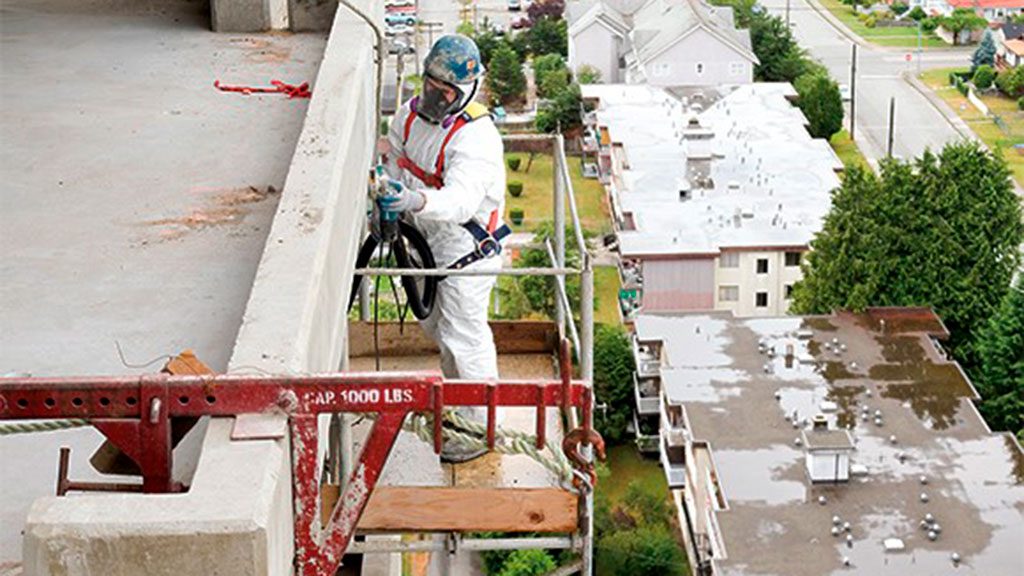It is estimated that nearly 400,000 Canadian workers are exposed to silica dust every year. Most being in the construction industry.
Silica crystals are found in natural materials such as sand, sandstone, granite, clay, shale and slate. Activity that creates dust can expose workers to airborne silica. Some common silica-containing materials found on construction sites are:
- Concrete, concrete block, cement and mortar
- Masonry, tiles, brick, refractory brick
- Granite, sand, fill dirt, top soil
- Asphalt containing rock or stone
- Abrasive used for blasting
Silica dust is the most widespread airborne hazard on a work site. The most common ways silica dust is created include:
- Chipping, sawing, grinding, hammering, or drilling
- Crushing, loading, hauling, or dumping
- Building demolition
- Power cutting or dressing stone
- Facade renovation, including tuck-point work
- Abrasive or hydro blasting
- Dry sweeping or pressurized air blowing
- Tunneling, excavating, or moving earth
How much dust is too much?
Inhaling microscopic particles of silica can permanently damage your lungs. Symptoms and diseases can develop within years of exposure to relatively low concentrations of airborne silica or as short a period of months after exposure to significantly higher concentrations. This takes into account individual factors such as age and health of the exposed worker which plays a significant role in the susceptibility of contracting an occupational disease. Exposures can lead to diseases such as silicosis, autoimmune disorders and lung cancer.
For most of Canada, the 8-hour exposure limit for crystalline silica is only 0.025 milligrams per cubic meter of air. It’s very likely that if you are standing in a cloud of dust on a construction site, you have been overexposed.
Preventing exposure to silica dust
The optimal way to prevent exposure to silica is to control the dust at its source. However, where this isn’t possible, applying controls to mitigate the dust or protect the worker directly (for example by using personal protective equipment such as respirators) can be effective as well. The following are proven methods of addressing exposure to silica dust:
- Provide engineering controls such as local exhaust ventilation or water spray systems to reduce dust levels
- Use barriers and signage to restrict access to unprotected workers
- Use appropriate PPE such as respirators and protective clothing
- Train workers on the dangers of silica exposure and how to properly use dust controls and PPE
- Develop and implement an Exposure Control Plan for silica.
An exposure control plan is a document developed by the employer that can manage the multiple controls implemented to ensure workers who are involved in a work activity that generates silica are properly protected. These plans include:
- Employer and worker responsibilities
- Risk assessments
- Silica dust controls
- Worker education and training
- Written safe work procedures
- Health monitoring
If you are a worker exposed to silica dust, you can do the following:
- Learn about the control methods that can protect you
- Ask your supervisor how you will be protected when performing dusty work
- Follow safe work procedures, and use respiratory protection
- Talk to your family doctor, who may recommend medical monitoring
Online silica control tool
To aid in the development of exposure control plans, the Silica Control Tool was created. Developed by the BC Construction Safety Alliance, in collaboration with WorkSafeBC and the University of B.C., this online resource enables employers to determine silica exposure levels in their workplace and helps you develop an exposure control plan.
With the silica tool, you can generate a custom exposure control plan for your particular work activities. The online tool works on desktops, tablets and smart phones — and exposure control plans can be managed and stored electronically.
The silica tool is currently available to B.C. employers on the BCCSA website (https://www.bccsa.ca/Silica-Control-Tool.html)
For more information on preventing exposure to silica in your workplace, visit worksafebc.com/silica
This content is sponsored by WorkSafeBC in collaboration with ConstructConnect® Media.




Recent Comments
comments for this post are closed